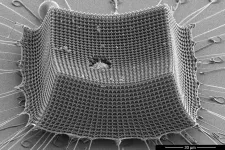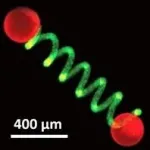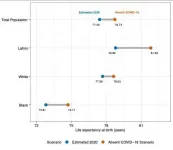(Press-News.org) 'Precision agriculture' where farmers respond in real time to changes in crop growth using nanotechnology and artificial intelligence (AI) could offer a practical solution to the challenges threatening global food security, a new study reveals.
Climate change, increasing populations, competing demands on land for production of biofuels and declining soil quality mean it is becoming increasingly difficult to feed the world's populations.
The United Nations (UN) estimates that 840 million people will be affected by hunger by 2030, but researchers have developed a roadmap combining smart and nano-enabled agriculture with AI and machine learning capabilities that could help to reduce this number.
Publishing their findings today in Nature Plants, an international team of researchers led by the University of Birmingham sets out the following steps needed to use AI to harness the power of nanomaterials safely, sustainably and responsibly:
Understand the long-term fate of nanomaterials in agricultural environments - how nanomaterials can interact with roots, leaves and soil;
Assess the long-term life cycle impact of nanomaterials in the agricultural ecosystem such as how how repeated application of nanomaterials will affect soils;
Take a systems-level approach to nano-enabled agriculture - use existing data on soil quality, crop yield and nutrient-use efficiency (NUE) to predict how nanomaterials will behave in the environment; and
Use AI and machine learning to identify key properties that will control the behaviour of nanomaterials in agricultural settings.
Study co-author Iseult Lynch, Professor of Environmental Nanosciences at the University of Birmingham, commented: "Current estimates show nearly 690 million people are hungry - almost nine per cent of the planet's population. Finding sustainable agricultural solutions to this problem requires us to take bold new approaches and integrate knowledge from diverse fields, such as materials science and informatics.
"Precision agriculture, using nanotechnology and artificial intelligence, offers exciting opportunities for sustainable food production. We can link existing models for nutrient cycling and crop productivity with nanoinformatics approaches to help both crops and soil perform better - safely, sustainably and responsibly."
The main driver for innovation in agritech is the need to feed the increasing global population with a decreasing agricultural land area, whilst conserving soil health and protecting environmental quality.
Intensification of agriculture has resulted in extremely poor global NUE, which poses a serious threat to environmental quality as large amounts of nutrients are lost to water and air - warming the planet, with nearly 11% of global greenhouse gas emissions coming from agriculture.
Of particular concern is the emission of the 'laughing gas' nitrous oxide as a result of excessive nitrogen fertilization of land, which is 300 times more potent than carbon dioxide in inducing global warming. Some 70% of the anthropogenic source nitrous oxide emissions into air are contributed from the agricultural sector.
Nano fertilizers offers the potential to target crop fertility, enhance NUE and reduce nitrous oxide emission, which can thus help support the net zero greenhouse gas emission by 2050 targets under the UK Climate Change Act.
The research team, which includes experts from the Hellenic Military Academy, in Vari, Greece and Novamechanics Ltd, in Nicosia, Cyprus, note that nanotechnology offers great potential to enhance agriculture in four key ways:
Improving production rates and crop yields;
Boosting soil health and plant resilience;
Improving the efficiency of resources, such as fertiliser, and reducing pollution; and
Developing smart sensor plants that can alert farmers to environmental stresses.
Co-author Dr Peng Zhang, a Marie Sk?odowska-Curie Research Fellow at the University of Birmingham, commented: "Computational approaches including AI and machine learning will have a critical role in driving the progress of nano-enabled agriculture. Such approaches are already starting to gain regulatory acceptance for safety assessment of nanomaterials, allowing the development of safe-by-design nanomaterials for consumer products and medicine.
"Integrating AI and nanotechnology into precision agriculture will play a vital role in probing the design parameters of nanomaterials for use in fertilizer and pesticide delivery to ensure minimal impacts on soil health coupled with minimal nanomaterial residues remaining in the edible tissue portions - helping to ensure safe and sustainable agriculture."
INFORMATION:
For more information, interviews or an embargoed copy of the research paper, please contact Tony Moran, International Communications Manager on +44 (0)782 783 2312. For out-of-hours enquiries, please call +44 (0) 7789 921 165.
Notes for editors
The University of Birmingham is ranked amongst the world's top 100 institutions, its work brings people from across the world to Birmingham, including researchers and teachers and more than 6,500 international students from over 150 countries.
'Nanotechnology and artificial intelligence to enable sustainable and precision agriculture' - Peng Zhang, Zhiling Guo, Sami Ullah, Georgia Melagraki, Antreas Afantitis and Iseult Lynch is published by Nature Plants.
A new study by engineers at MIT, Caltech, and ETH Zürich shows that "nanoarchitected" materials -- materials designed from precisely patterned nanoscale structures -- may be a promising route to lightweight armor, protective coatings, blast shields, and other impact-resistant materials.
The researchers have fabricated an ultralight material made from nanometer-scale carbon struts that give the material toughness and mechanical robustness. The team tested the material's resilience by shooting it with microparticles at supersonic speeds, and found that the material, which is thinner than the width of a human hair, prevented the miniature projectiles from tearing through ...
HAMILTON, ON June 24, 2021 -- The idea of visiting the doctor's office with symptoms of an illness and leaving with a scientifically confirmed diagnosis is much closer to reality because of new technology developed by researchers at McMaster University.
Engineering, biochemistry and medical researchers from across campus have combined their skills to create a hand-held rapid test for bacterial infections that can produce accurate, reliable results in less than an hour, eliminating the need to send samples to a lab.
Their proof-of-concept research, published today in the journal Nature Chemistry, specifically describes the test's ...
In a few years, a new generation of quantum simulators could provide insights that would not be possible using simulations on conventional supercomputers. Quantum simulators are capable of processing a great amount of information since they quantum mechanically superimpose an enormously large number of bit states. For this reason, however, it also proves difficult to read this information out of the quantum simulator. In order to be able to reconstruct the quantum state, a very large number of individual measurements are necessary. The method used to read out the quantum state of a ...
A University of Bristol-led team of international scientists with an interest in protoliving technologies, has today published research which paves the way to building new semi-autonomous devices with potential applications in miniaturized soft robotics, microscale sensing and bioengineering.
Micro-actuators are devices that can convert signals and energy into mechanically driven movement in small-scale structures and are important in a wide range of advanced microscale technologies.
Normally, micro-actuators rely on external changes in bulk properties such as pH and temperature to trigger repeatable mechanical ...
What The Study Did: Researchers found no association between recent vaccination with the Pfizer-BioNTech BNT162b2 COVID-19 vaccine and risk of facial nerve palsy.
Authors: Asaf Shemer, M.D., of the Shamir Medical Center in Be'er Ya'akov, Israel, is the corresponding author.
To access the embargoed study: Visit our For The Media website at this link https://media.jamanetwork.com/
(doi:10.1001/jamaoto.2021.1259)
Editor's Note: Please see the article for additional information, including other authors, author contributions and affiliations, conflict of interest and financial disclosures, and funding and support.
INFORMATION:
Media ...
What The Study Did: Researchers estimated the change in life expectancy associated with the COVID-19 pandemic in the United States by race/ethnicity.
Authors: Theresa Andrasfay, Ph.D., of the University of Southern California, Los Angeles, is the corresponding author.
To access the embargoed study: Visit our For The Media website at this link https://media.jamanetwork.com/
(doi:10.1001/jamanetworkopen.2021.14520)
Editor's Note: The article includes funding/support disclosures. Please see the article for additional information, including other authors, author contributions and affiliations, conflict of interest and financial disclosures, and funding and support.
INFORMATION:
Media advisory: The full study is linked to this news release.
Embed ...
What The Study Did: Patients with COVID-19-related loss of smell were evaluated for one year after the diagnosis.
Authors: Marion Renaud, M.D., of University Hospitals of Strasbourg, France, is the corresponding author.
To access the embargoed study: Visit our For The Media website at this link https://media.jamanetwork.com/
(doi:10.1001/jamanetworkopen.2021.15352)
Editor's Note: The article includes funding/support disclosures. Please see the article for additional information, including other authors, author contributions and affiliations, conflict of interest and financial disclosures, and funding and support.
INFORMATION:
Media advisory: The full study is linked to this news release.
Embed this link to provide ...
What The Study Did: The incidence of Bell palsy among patients with COVID-19 was compared with individuals vaccinated against the disease.
Authors: Akina Tamaki, M.D., of the University Hospitals Cleveland Medical Center, is the corresponding author.
To access the embargoed study: Visit our For The Media website at this link https://media.jamanetwork.com/
(doi:10.1001/jamaoto.2021.1266)
Editor's Note: The article includes conflicts of interest disclosures. Please see the article for additional information, including other authors, author contributions and affiliations, conflict of interest and financial disclosures, and funding and support.
INFORMATION:
Media advisory: ...
An updated analysis of American COVID-19 deaths throughout 2020 reveals an even bigger drop in average life expectancy as well as still-substantial disparities by race and ethnicity.
Lead author Theresa Andrasfay, a postdoctoral scholar at the USC Leonard Davis School of Gerontology, and coauthor Noreen Goldman of Princeton University first examined the pandemic's effect on American life expectancy in October 2020. Their initial study, published in Proceedings of the National Academy of Sciences in January 2021, showed the largest single-year decline in life expectancy in at least 40 years and the lowest life expectancy estimated since 2003.
The updated analysis, which included the more than 380,000 US COVID-19 deaths in 2020 and used 2018 life expectancies as a comparison, ...
When cancers metastasize, cells from the primary tumor break away, travel through the blood or lymph system,
and form new tumors in other body parts. Although metastasis are responsible for more than 90% of all cancer
deaths, limited progress has been made in treating cancers that have spread.
Besides DNA, RNA is the other molecule of life. For several years now, RNA has become just as important as DNA in understanding the book of life. Especially, messenger RNA (mRNA), the basis of the Covid-19 vaccines, has been put in the spotlight. Just as with DNA, in addition to the 4 well known letters (A, U, G, C), there are further letters defining the RNA alphabet or ...




